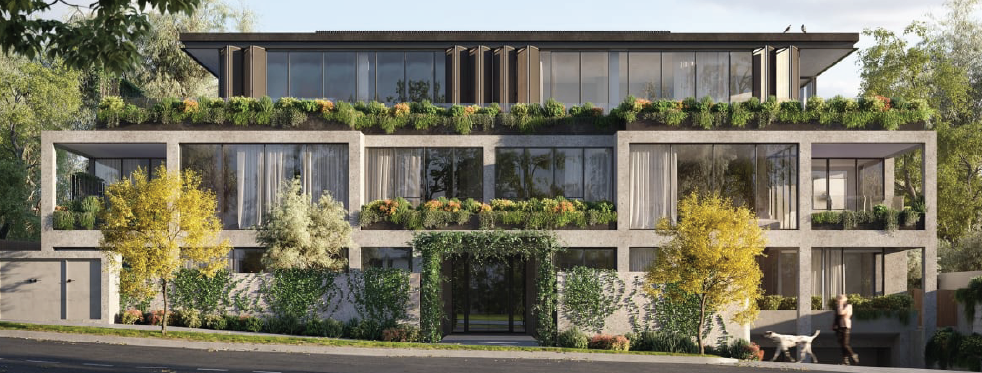
IMAGE: Provenance – 890 Toorak Road, Camberwell
Planter boxes are now becoming an important design element for brand new developments however the question lies whether to make the location of planter boxes on common property or private property.
The following are The Knight’s pros and cons list for the location of the planter boxes.
Located on common property
PROS
- The Owners Corporation (OC) are able to maintain the property’s aesthetics by arranging maintenance.
CONS
- Access can be difficult and expensive:
- Access is unable to be obtained via private Lots (i.e apartments, townhouses). If access is required onto private property (i.e. courtyard, balcony) then an access licence agreement or defined easement of title should be considered.
- Access may include via rope access from the rooftop or elevated work platform (EWP). Rope access requires licenced contractors which attracts a premium cost. The use of EWP can also be expensive to hire, and permits will possibly be required from local council in relation to power lines, blocking off pathways, roads etc
- The OC may decide not to maintain the plants due to the associated costs:
- It’s suggested a Deed is implemented to ensure the OC maintains the planter boxes throughout the year.
Located on private property
PROS
- The OC is not liable for the cost of maintenance which reduces the OC fees.
CONS
- Relying on Lot owners to maintain the planter boxes which will likely result in an incohesive aesthetic;
- An Owners Corporation Rule can be added to ensure the maintenance from the Lot owner, however this doesn’t mean it will be adhered to.
- If the Lot owner fails to maintain the planter box, the OC can issue a ‘Notice to Maintain’ which gives the OC the right, after a certain period of time, to access and undertake maintenance, at the owner’s expense. Enforcement can still be challenging despite this process.
The Knight’s recommendations
It is recommended that planter boxes are located on common property with the following to be implemented as per the recommendation.
- As part of the design and installation, the following to be considered:
- Locate planter boxes in areas that can easily be accessed.
- Engage a high rope access consultant (i.e. Altitude Façade Access Consulting, Vertigo High Access Specialists) to determine locations to install anchor points/fall arrest systems for the purpose of maintaining planter boxes (in addition to other areas of the façade that require cleaning, such as windows, that cannot be easily accessed by occupiers).
- Planter boxes be fitted with irrigation systems and connected to the common water meter for the Owners Corporation to pay for water usage.
If planter boxes are to be located on private property, there is still a way to ensure that the Owners Corporation is responsible to maintain by undertaking the following:
- An Access Licence Agreement is entered into between each Lot and the Owners Corporation which allows the following (NB: We recommend seeking legal advice in relation to the ability for the licence agreement to transfer to subsequent Lot owners):
- The Owners Corporation to undertake maintenance of planter boxes. Access to be via rope access or EWP.
- Occupiers are to not tamper with irrigation infrastructure as the irrigation is connected to the common water meter and the Owners Corporation is responsible to pay for water usage.
- The Owners Corporation is to replace dead/unhealthy plants.
- At the Inaugural General Meeting, special resolutions to be passed for the following:
- Access Licence Agreements to be entered into between each Lot and the Owners Corporation.
- That the Owners Corporation will provide a service to all Lots to maintain the planter boxes located on private property.





